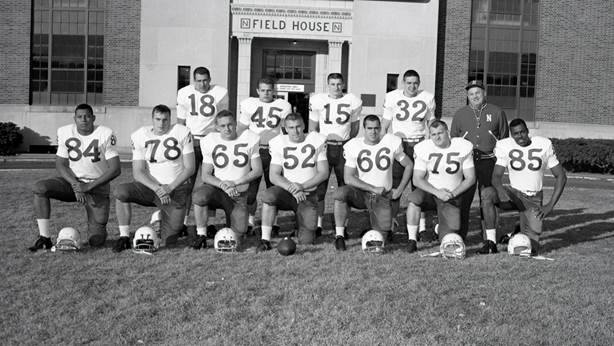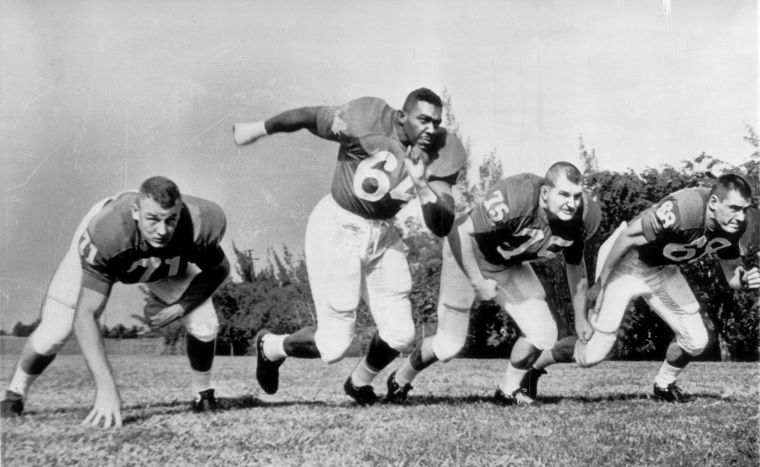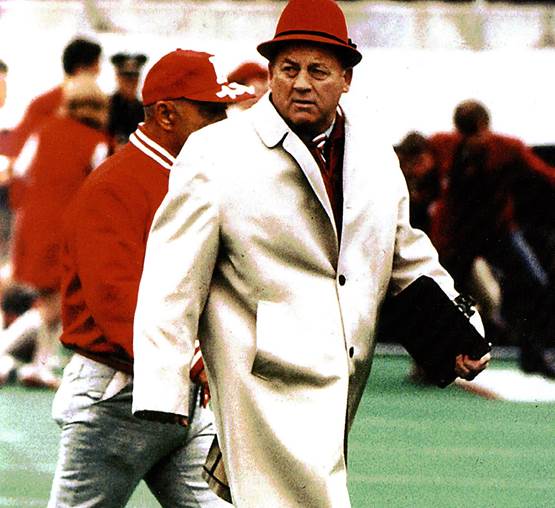

BOB DEVANEY AND HIS CORNHUSKERS, PART TWO
HELMET HUT NEWS/REFLECTIONS July 2015:
BOB DEVANEY AND HIS CORNHUSKERS, PART TWO
By Dr. Ken
The first thing Devaney
discovered upon his arrival in
Lincoln, was a Nebraska program
in a state of disorganized
chaos, but one that had talent.
Assistant coach George Kelly who
was at Nebraska in 1961 and
remained there with Devaney from
’62 through 1969 until leaving
for the Notre Dame staff, said
that Devaney “was amazed at how
much talent there was and he
knew exactly what to do to
organize it. He always seemed to
be playing people in the right
positions.” Unlike some of the
successful coaches of his era,
he also got a lot of work from
his players because they enjoyed
playing for him. Kelly stated
that “…the key things were his
recruiting and the way he gets
along with people. Everybody
likes him. The kids liked him.
He would just go into these
small towns in Nebraska and sit
in the bars and entertain
people.” As a testament to his
players’ feelings towards him,
at a luncheon prior to the 1969
Sun Bowl, he was given a three
minute standing ovation by his
own players! During the
tumultuous times of the ‘60’s,
with many football programs
wrestling with the demands and
assimilation of African American
players, Nebraska residents
found that their head coach was
indeed blind to the color of his
players with a well-earned
reputation for fairness. He
actively recruited African
Americans from New Jersey, from
the south, and from California.
When these same players formed a
Black Caucus in the late ‘60’s
to request that the staff
acquiesce to a list of
suggestions, they found that
there really was nothing to ask
for, Devaney already treated his
players fairly and without
prejudice. One former player
summed it up by stating, “You
would absolutely die for Coach
Devaney.”
 |
By 1965 Devaney had solidified Nebraska as a program to be reckoned with and donned them in distinctive uniforms with immediately recognizable stylized numerals
As it was at Wyoming, Devaney and his staff out-recruited the other programs in the area. Realizing that many of the state’s players had potential but needed time to adapt from the eight-man football game played in many parts of the state due to the small and scattered population, he instituted an extensive redshirt program. Success was immediate with his 1962 squad going 9-2, and though it can be agreed upon that Oklahoma, which had dominated the Big Eight Conference since the mid-1940’s had taken a step back, Nebraska was legitimately in the mix for national recognition. He brought the Huskers to four consecutive Big Eight titles, five consecutive bowl games, and at least a top six national ranking from ’63 through ’66.
Devaney’s first team set the tone, as did Devaney himself. Perhaps it was an ill-advised statement relative to the probation that his Wyoming program was smacked with for illegal recruiting benefits in 1957, but the new head coach immediately stated, albeit in a humorous manner, “We don’t want to win enough to get on probation, just enough to be investigated.” Despite seven losing seasons, the Huskers had talent although the disappointing three-win 1961 season could be summarized with the statement, “Big team, but a really slow team.” Devaney’s philosophy was to keep them large but produce a bit faster bunch of tough guys. Fullback Bill “Thunder” Thornton had been All Conference in ’61, with halfback Rudy Johnson and quarterback Dennis Claridge showing signs of life. Huge for the day at 6’4” and 251 pounds, two-way tackle Robert Brown, who would later develop into the Hall of Famer known to the football public as the 280 pound “Boomer” Brown was quick enough to drop into pass coverage from a linebacker’s position or from the defensive line. The Cornhuskers 9-2 record was augmented by a 36-34 victory over Miami in the Gotham Bowl but was merely a prelude to Devaney’s presentation of “his kind of team” that took the field in 1963.
For better or worse, he had immediately set a very high standard. The ’62 team averaged thirty-two points per game, an increase from the eleven per game the previous season. The Huskers nine wins were well beyond the expectations of the most enthusiastic and optimistic followers and the initial call for the entire state to wear red, fill the stadium, and donate as little as one dollar per year to the program, created a groundswell of support and a bit of fan frenzy. Almost immediately erasing fan apathy with a bowl victory and national ranking, Devaney was the picture of the evangelical carrier of good news about his program as he criss-crossed the state forming booster club chapters and making all Nebraska residents feel as if they were part of the process. He received pledges from the newly established Husker Beef Club, a group of cattlemen, for donations of 200 butchered steers to provide prime meat for the squad. He encouraged red hats, red shirts, red pants, and red cowboy boots as haute couture for game day wear. In one season he managed to convince enough fans to travel to away games so that over time the sea of red in opponents’ stadiums altered the atmosphere of those contests. Kansas coach Pepper Rodgers told Devaney that the size of the crowds that followed them out of town to see their Huskers play, made him feel that the games at Kansas were much more like Nebraska home games.
The multiple offense, with
Rudy Johnson a national top
ten finisher in yards per
carry, had the country’s
best rushing offense, the
fifth best scoring offense,
and a total offensive count
that left them ranked at
number eight at the end of
the season. The Orange Bowl
victory over Auburn produced
a 10-1 finish with a
mid-season 17-13 loss to Air
Force as the only blemish.
Whoever viewed their Big
Eight title and Number Six
end-of-season ranking,
scratched their heads and
asked, “Where did they come
from?” wasn’t alone but the
Nebraska program had entered
a new dimension.
 |
Ascension to the top of the Big Eight Conference was one matter, but Devaney and his staff traveled the nation seeking out players who would fit into the conservative social environment of Lincoln, Nebraska. Devaney’s folksy, down-home manner continued to win over players and parents even as the college cultural scene became radicalized. Nebraska games became the place to go for excellent football and an enjoyable Saturday afternoon. During the Devaney era, Memorial Stadium was expanded four times, enhancing seating from 30,000 to 76,000 and individuals began to bequeath their season tickets in their last will and testaments. Devaney was not the revered “X’s and O’s coach” that some were, or a legendary motivator in the mold of a Bear Bryant. He was a coach that players would go all out for and he had a knack for knowing what position would best suit a specific player’s skills. Through it all, he remained modest and by all accounts, witty and fun to be with. Typical was the story that made some of the religious followers of Husker football at first take a step back, with the conversation stated, “Is it true that you’ve sung ‘Bringing In The Sheaves’ to a player’s mother in order to get her son to come to Nebraska?” Devaney replied, “Yes, I did that. The mother came to Nebraska and the boy enrolled at Missouri.”
Devaney was one of
the first of the big
name, mid to
late-Sixties coaches
who did not have
rules regarding
length of hair,
facial hair, or
style of dress as
long as his players
obeyed the
university code of
conduct and
dedicated themselves
to the team effort.
His assistant
coaches were always
viewed as being
“accessible” and
Devaney himself had
an open door policy
that the players
took advantage of.
He knew that it was
important for his
players to feel as
if they were a part
of the campus
community and
allowed them to
behave like other
college students.
One player stated
that “The big thing
was the closeness.
The players got
along. No race
problems, no
nothing.” Devaney
went out of his way
to provide
second-chances to
players who deserved
it and pushed them
to both remain in
school and earn
their degrees.
 |
The “First Act” of Devaney’s Nebraska dynasty lasted from 1962 through the ’66 season, with 9-2, 10-1, 9-2, 10-1, and 9-2 records. As Big Eight Champions Nebraska became major bowl game participants and although they lost the Cotton Bowl to Arkansas following the ’64 season and two consecutive bowl games to Alabama, one in the Orange Bowl and the 1966 season ending game in the Sugar Bowl, they were now a national player. Devaney had taken his initial “big but slow” squad and recruited it into a faster team but the bowl losses to the extremely quick Bama squads and to Arkansas indicated what the future would bring. Consecutive 6-4 seasons in 1967 and ’68 came from lackluster recruiting and the process of reshaping the aggressive, tough, and swarming type of group that Devaney envisioned. The ship would be righted for the final act of Devaney’s coaching career, one that placed him at the pinnacle of his profession.
Part 3 To
Follow: